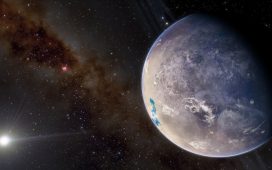It feels like there have been staggering science stories emerging every other day recently, all of which have blown our tiny little minds.
First, there was the discovery of a terrifying black hole pointing right at us, then there was a huge hole found in the sun and a missing continent found after going missing for 375 years.
Now, people are only just realising that there’s a massive ocean hidden under the Earth’s crust.
It turns out there’s a huge supply of water 400 miles underground stored in rock known as ‘ringwoodite’.
Scientists previously discovered that water is stored inside mantle rock in a sponge-like state, which isn’t a liquid, solid or a gas, but instead a fourth state.
The scientific paper titled ‘Dehydration melting at the top of the lower mantle’ was published in 2014 and laid out the findings.
 There’s three times as much water below the surface than in the oceansiStock
There’s three times as much water below the surface than in the oceansiStock
“The ringwoodite is like a sponge, soaking up water, there is something very special about the crystal structure of ringwoodite that allows it to attract hydrogen and trap water,” said geophysicist Steve Jacobsen at the time.
“This mineral can contain a lot of water under conditions of the deep mantle,” added Jacobsen, who was part of the team behind the discovery.
He added: “I think we are finally seeing evidence for a whole-Earth water cycle, which may help explain the vast amount of liquid water on the surface of our habitable planet. Scientists have been looking for this missing deep water for decades.”
Scientists made the findings at the time after studying earthquakes and discovering that seismometers were picking up shockwaves under the surface of the Earth.
From that, they were able to establish that the water was being held in the rock known as ringwoodite.
If the rock contained just 1 per cent water, it would mean that there is three times more water under the surface of the Earth than there is in the oceans on the surface.
It’s not the only significant discovery made by scientists recently, either. In fact, researchers found an entirely new ecosystem when turning over volcanic crust with the aid of an underwater robot, showing that even now, nature has many more secrets to unearth.
That’s not all! Here’s the best of our science coverage:
This article was first published on 29th March 2023
Sign up for our free Indy100 weekly newsletter
Have your say in our news democracy. Click the upvote icon at the top of the page to help raise this article through the indy100 rankings.












